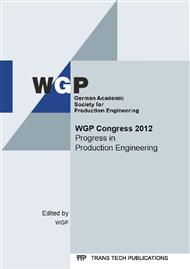[1]
Pehnt, M. et al., Elektroautos in einer von erneuerbaren Energien geprägten Energiewirtschaft. Zeitschrift für Energiewirtschaft. 35(2011)3, 230-231.
DOI: 10.1007/s12398-011-0056-y
Google Scholar
[2]
Notter, D. et al., Contribution of Li-Ion Batteries to the Environmental Impact of Electric Vehicles. Environmental Science & Technology. 44(2010)17, 6550-6556.
DOI: 10.1021/es903729a
Google Scholar
[3]
Kaiser, O. S., Meyer. S., Schippl, J. (2011) Elektromobilität. ITA-Kurzstudie.
Google Scholar
[4]
Volkswagen Media Services, Forschungskonsortium entwickelt Leichtbaukarosserie für Elektrofahrzeuge. https: /www. volkswagen-mediaservices. com/medias_publish/ms/content/de/pressemitteilungen/2011/12/08/forschungskonsortium. standard. gid-oeffentlichkeit. html. Accessed 8 December (2011).
Google Scholar
[5]
DIN Deutsches Institut für Normung e.V. (2006) DIN EN ISO 14044. Ökobilanz – Anforderungen und Anleitungen.
Google Scholar
[6]
Volkswagen Media Services, Der Golf. https: /www. volkswagen-mediaservices. com/medias_publish/ms/content/de/pressemitteilungen/2008/03/04/der_golf. standard. gid-oeffentlichkeit. html. Accessed 4 March (2008).
Google Scholar
[7]
Eckstein, L. et al. (2010) Analyse sekundärer Gewichtseinsparungspotentiale in Kraftfahrzeugen.
Google Scholar
[8]
Stichling, J., Hasenberg, V. (2010) Recycling im Automobil-Leichtbau.
Google Scholar
[9]
DIN Deutsches Institut für Normung e.V. (2009) Ökobilanz - Grundsätze und Rahmenbedingungen.
Google Scholar
[10]
Bauer, C., Poganietz, W. -R. (2007) Prospektive Lebenszyklusanalyse oder die Zukunft der Ökobilanz. Technikfolgenabschätzung – Theorie und Praxis, 16(2007)3.
DOI: 10.14512/tatup.16.3.17
Google Scholar
[11]
Poganietz, W. -R. (2008) Consequential LCA – eine notwendige Weiterentwicklung des LCA?. Workshops Energiesystemanalyse, , 27. November 2008 at KIT Zentrum Energie, Karlsruhe.
Google Scholar
[12]
Verband der Automobilindustrie - VDA (2011) Automobilproduktion, http: /www. vda. de/de/zahlen/jahreszahlen/automobilproduktion. Accessed 9 November (2011).
Google Scholar
[13]
Walk, W. (2010).
Google Scholar
[15]
European Commission (2010) ILCD handbook – General guide for Life Cycle Assesement, Luxemburg: Publications office of the European Union, (2010).
Google Scholar
[16]
Frischknecht, R. (2000) Allocation in Life Cycle Inventory Analysis for Joint Production. International Journal of LCA, 5(2000)2.
DOI: 10.1007/bf02979729
Google Scholar
[17]
Frischknecht, R., Life cycle inventory modeling in the Swiss national database ECOINVENT 2000. Hilti, L. M.; Gilgen, P. W. (editor): Sustainability in the Information Society, 15th International Symposium Informatics for Environmental Protection, ETH Zürich, Metropolis Verlag, Marburg, 2001, 699-708.
Google Scholar
[18]
Braess, H. -H., Vieweg-Handbuch Kraftfahrzeugtechnik, Vieweg, Wiesbaden, (2007).
Google Scholar
[19]
Verein Deutscher Ingenieure, VDI-Berichte 1543 – Entwicklungen im Karosseriebau, VDI-Verl, Düsseldorf, (2000).
Google Scholar
[20]
Beiss, P., Umdruck Werkstoffkunde 1, 2009, Druck-& Verlagshaus Mainz GmbH, Aachen.
Google Scholar
[21]
Fritz, A. H., Fertigungstechnik, Springer, Berlin (2008).
Google Scholar
[22]
Friedel, M., Modularer Baukasten zur Realisierung von Rohbauten, Fellbach (2003).
Google Scholar
[23]
Löschmann, F. (2003) Der neue Golf V von Volkswagen – Umbruch in der Karosseriebautechnik, Fellbach, (2003).
Google Scholar
[24]
Dilthey, U., Trube, S. et al., Schweißtechnische Fertigungsverfahren-Schweiß- und Schneidtechnologien, 3. Auflage, Springer, Berlin, (2005).
Google Scholar
[25]
Vogt, M., Mechanisiertes MIG-Schweißen von Magnesiumlegierungen, (2005).
Google Scholar
[26]
Verein Deutscher Ingenieure, VDI-Berichte 1307 – Ganzheitliche Betrachtungen im Automobilbau. VDI-Verl, Düsseldorf (1996).
Google Scholar
[27]
Klöpffer, W., Ökobilanz (LCA) – Ein Leitfaden für Ausbildung und Beruf. Wiley-VCH, Weinheim, (2009).
DOI: 10.1002/9783527627158
Google Scholar
[28]
Gerschler, J.B., Sauer, D.U., Batterien für Elektrofahrzeuge-Stand und Ausblick, Berliner Energietage (2010).
Google Scholar
[29]
VDE, Roland Berger, Nationale Plattform Elektromobilität (2012) E-Mobility- Batteriesystem. http: /www. vde. com/de/E-Mobility/Fahrzeugtechnik/Batteriesystem/Seiten/default. aspx., Accessed 25 March. (2012).
Google Scholar
[30]
VDI, SB LiMotiv, Luftiger, Akku für weitreichende Elektromobiltität. http: /www. vdi-nachrichten. com/artikel/Luftiger-Akku-fuer-weitreichende-Elektromobilitaet/55376/2. Accessed 14 November (2011).
Google Scholar
[31]
Hören, B., Lesemann, M., Dux, E., Finaler Stand - Konservatives Konzept und Zielgewicht (Light-eBody). Aachen, Januar (2012).
Google Scholar
[32]
Kampker, A., Grundlagen zur Produktion von HV-Batterien. unpublished manuscript, Autouni, Wolfsburg, (2011).
Google Scholar
[33]
Kampker, A., Franzkoch, B., Nowacki, C., Networked product and production development for lithium-ion batteries. 4th International Conference on Changeable, Agile, Reconfigurable and Virtual Production (CARV2011), Montreal, Canada (2011).
DOI: 10.1007/978-3-642-23860-4_35
Google Scholar
[34]
NPE – Nationale Plattform Elektromobilität, Zwischenbericht. Berlin, November (2010).
Google Scholar
[35]
Hören, B., Dokumentation Arbeitstreffen AP1 im Rahmen des Light-eBody Projektes. Aachen, November (2011).
Google Scholar
[36]
Helms, H. et al., Electric vehicle and plug-in hybrid energy efficiency and life cycle emissions, (2010).
Google Scholar
[37]
Althaus, H. -J., et al., Vergleichende Ökobilanz individueller Mobilität, (2010).
Google Scholar
[38]
Blesl, M. et al., Entwicklungsstand und –perspektiven der Elektromobilität. 18th International Symposium Transport and Air Pollution, (2010).
Google Scholar
[39]
Wellbrock, P. et al., Bewertung der CO2-Emissionen von Elektrofahrzeugen - Stand der wissenschaftlichen Debatte, (2011).
Google Scholar
[40]
Buchert, M. et al., Ökobilanz zum Recycling von Lithium-Ionen-Batterien, (LithoRec), (2011).
Google Scholar
[41]
Treffer, F. et al., Entwicklung eines realisierbaren Recyclingkonzeptes für die Hochleistungsbatterien zukünftiger Elektrofahrzeuge – Lithium-Ionen Batterierecycling Initiative (LiBRi), (2011).
Google Scholar
[42]
European Council for automotive R&D. Well-to-Wheel analysis of future automotive fuels and powertrains in the European context, (2006).
Google Scholar


